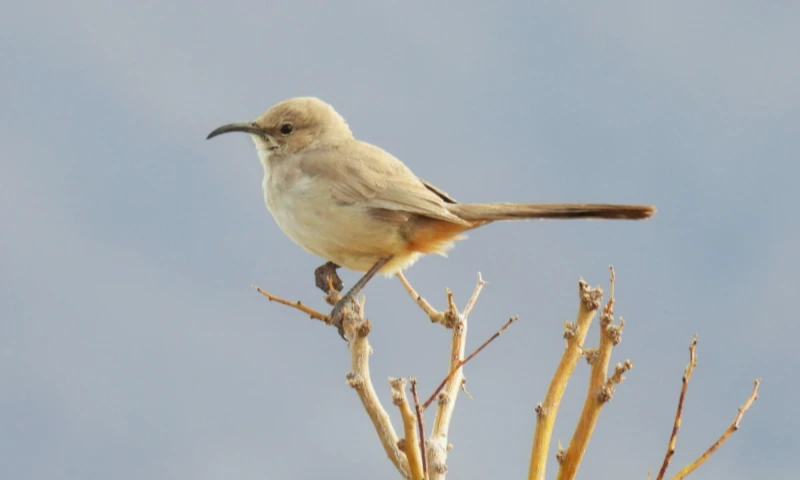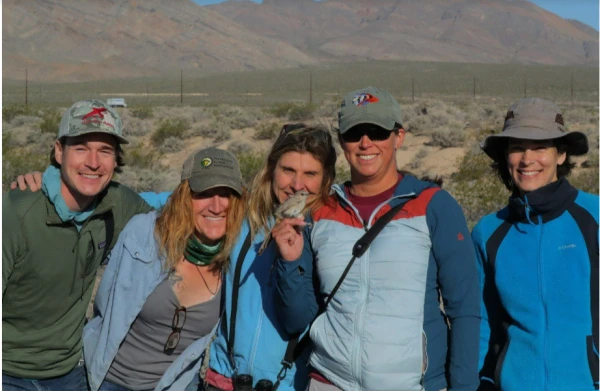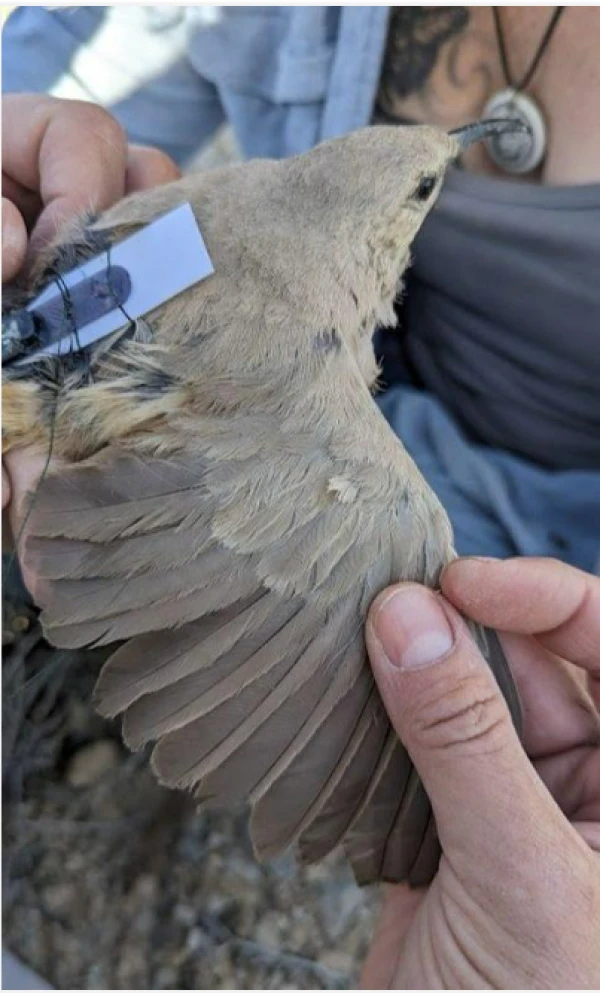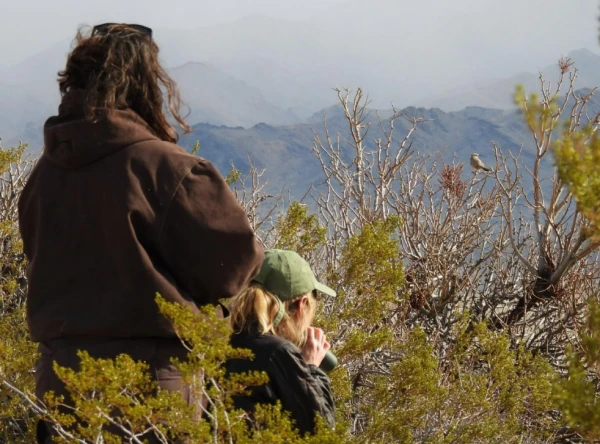By Morrigan DeVito
Photo Credit: Jeanne Tinsman
One LeConte’s Thrasher has left a big mark on Nevada bird records. On September 6, our partners at the Great Basin Bird Observatory (GBBO) announced that they tagged and banded the first ever LeConte’s Thrasher at a Motus station. This bird was captured at Tule Springs National Monument and will show biologists how it uses saltbush habitat, a key step in better understanding this species for their conservation.
What is Motus?
The Motus Wildlife Tracking System (Motus for short) is a radio telemetry project that allows researchers to track birds, bats, and insects on a landscape scale. Small radio transmitter tags are attached to animals so that when they fly by a Motus station (which look like radio towers), a signal pings the station and the animal’s date, time, and location data are recorded. Traditionally, Motus has been used to track migratory birds to better understand how they move across the landscape. But the LeConte’s Thrasher Motus project is unique in tracking a non-migratory species, as these birds stay in Nevada year-round.
The LeConte’s Thrasher is a bird that requires creativity to track. They have a reputation for being secretive and hard to study, so not much is known about their life history. Their pale, sandy feathers make them blend into the desert, and they often forage for insects beneath a sea of saltbush, hidden from view. To learn more about this ghost of the saltbush-scrub, biologists are using all the tactics they can, from field surveys to this new Motus tagging project.
Current Thrasher Research
According to Lauren Harter, a biologist at GBBO, the goals of their current thrasher research project are to better understand how LeConte’s Thrashers move across the landscape, what habitat they occupy, and the size of their home range and territory. “Home range” refers to anywhere a bird wanders, whereas a territory is an area a bird defends, such as nesting territory during the breeding season. Together, this information will paint a fuller picture of the LeConte’s Thrasher life history, something that is crucially needed to better conserve this species.
As you can expect from such a secretive bird, the LeConte’s Thrasher is difficult to capture. Biologists from agencies far and wide came together, with partners from GBBO, U.S Fish & Wildlife Service, Arizona Game & Fish, American Bird Conservancy, Point Blue Conservation Science, and others. Together they scoured the mixed saltbush-creosote scrub habitat for nests. Typically, the LeConte’s Thrasher nests in thorny cholla or saltbush plants, and the biologists found a nest with three young inside.
To catch this record-setting LeConte’s Thrasher, biologists also set up mist nets, made a LeConte’s Thrasher decoy, mounted a deceased specimen, and played LeConte’s Thrasher songs and calls to lure a thrasher in.
These tactics paid off, and after much anticipation (especially after being unsuccessful in capturing a LeConte’s Thrasher last year) a LeConte’s Thrasher flew into the mist net. Biologists carefully untangled it from the fine threads, tagged it with a small nanotag, and released it shortly after capture.
Next Steps
Unknown to this LeConte’s Thrasher, it’s now a crucial piece of the conservation puzzle. Motus nodes, which are smaller than traditional Motus towers, were set up in and around its territory. Now, anytime that bird flies within range of a node, it will automatically update with the location and time data.
As more data is collected, biologists will be able to see precisely how this thrasher uses its territory. For example, does it travel far to feed? Will it spend the winter there? The fact that this thrasher was captured in a mixed creosote-saltbush habitat is also important, and Harter wonders how this bird’s movements would differ if it was in pure saltbush or a desert wash habitat.
Amid many questions, one thing is certain: this bird will provide crucial data on how thrashers use mixed creosote-saltbush habitat at the northernmost end of their range.
Thrasher Conservation in Nevada
When the pieces are put together, this information will help Nevada’s wildlife refuges, national monuments, and other agencies better understand how to take care of the LeConte’s Thrasher. For example, biologists can ensure that habitat restoration efforts are done in the LeConte’s Thrasher’s best interest. There will also be a better understanding of what habitat should be prioritized for protection. For an example of how conserving LeConte’s Thrashers has helped protect public land, read this piece on thrasher conservation in Avi Kwa Ame National Monument.
LeConte’s Thrashers are monitored by GBBO and Partners in Flight as Red Watch List birds because they are at risk of population collapse. According to the North American Breeding Bird Survey, their populations declined 68% between 1968 and 2015. They are also a priority for the Desert Thrasher Working Group, a team of agencies who work together to research and monitor LeConte’s Thrashers (along with Bendire’s Thrashers and Loggerhead Shrikes) in order to better inform land management decisions.
The LeConte’s Thrasher tagged for Motus may be just one bird, but it marks how a fuller picture is coming together about thrasher conservation. Finding and tagging this bird would not have been possible without the cooperation, funding, and hard work of many people. Dawn Fletcher, a thrasher biologist at GBBO and coordinator for this project, especially wants to thank Erin Eichenberg and John Mark Simmons of Tule Springs NPS, as well as Kevin DesRoberts and Becky Lausch of U.S Fish & Wildlife Service.













